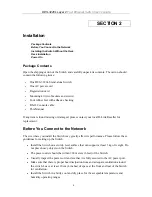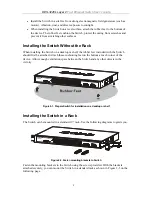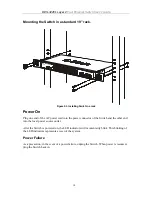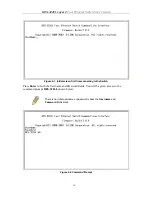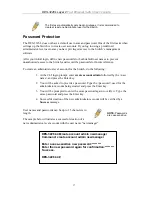
DES-3226L Layer 2
Fast Ethernet Switch User’s Guide
In addition, the Switch has 2 Mini-GBIC combo ports. These two-gigabit combo ports are
ideal for connecting to a server or network backbone.
This stand-alone Switch enables the network to use some of the most demanding multimedia
and imaging applications concurrently with other user applications without creating
bottlenecks. The built-in console interface can be used to configure the Switch’s settings for
priority queuing, VLANs, and port trunk groups, port monitoring, and port speed.
Features
•
IEEE 802.3 10BASE-T compliant
•
IEEE 802.3u 100BASE-TX compliant
•
IEEE 802.1p Priority Queues
•
IEEE 802.3x flow control in full duplex mode
•
IEEE 802.1x Port-based Access Control
•
IEEE 802.1Q VLAN
•
IEEE 802.1D Spanning Tree support
•
High performance switching engine performs forwarding and filtering at full wire speed,
maximum 14, 881 packets/sec on each 10Mbps Ethernet port, and maximum 148,810
packet/sec on 100Mbps Fast Ethernet port.
•
Full- and half-duplex for both 10Mbps and 100Mbps connections. Full duplex allows the
switch port to simultaneously transmit and receive data. It only works with connections to
full-duplex-capable end stations and switches. Connections to a hub must take place at half-
duplex
•
Support broadcast storm filtering
•
Non-blocking store and forward switching scheme capability to support rate adaptation and
protocol conversion
•
Supports by-port Egress/Ingress rate control
•
Efficient self-learning and address recognition mechanism enables forwarding rate at wire
speed
•
Support port-based enable and disable
•
Address table: Supports up to 4K MAC addresses per device
•
Supports a packet buffer of up to 3 Mbits
•
Supports Port-based VLAN Groups
•
Port Trunking with flexible load distribution and fail-over function
•
Supports Link Aggregation Control Protocol
•
Supports port segmentation
•
IGMP Snooping support
•
SNMP support
3




















